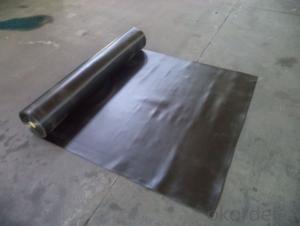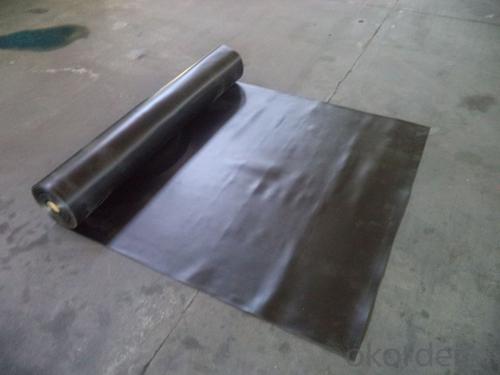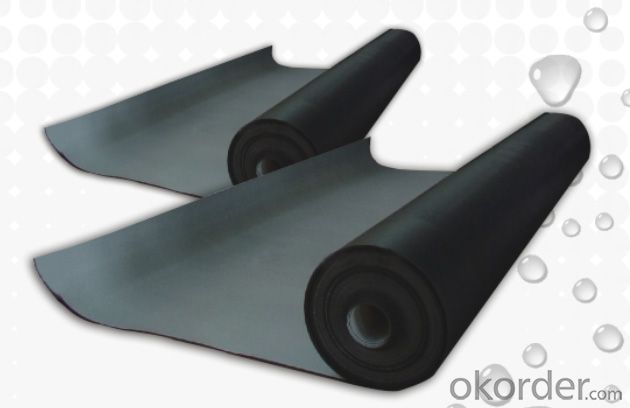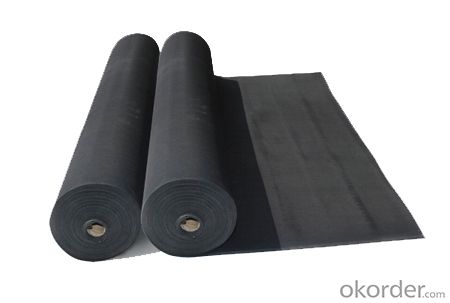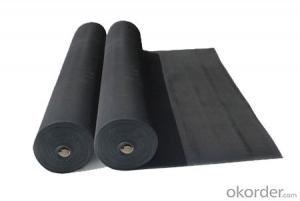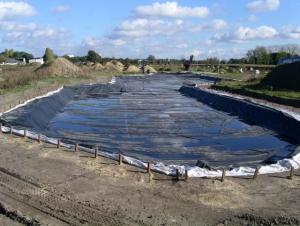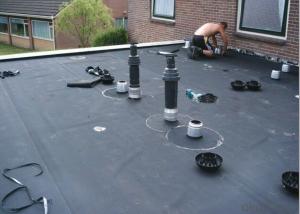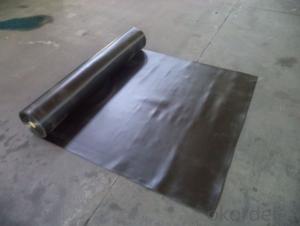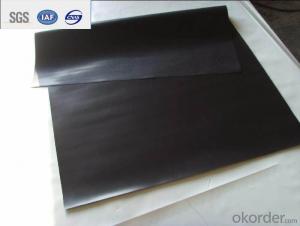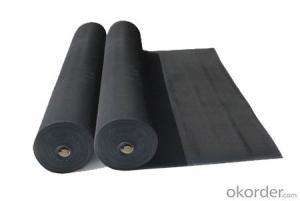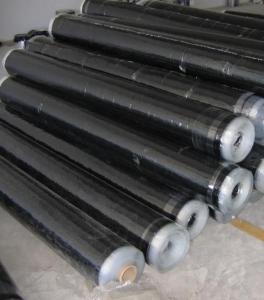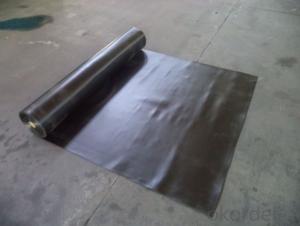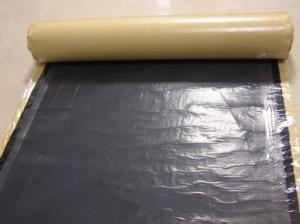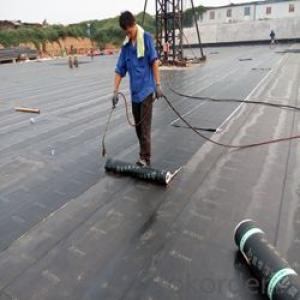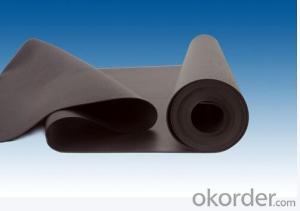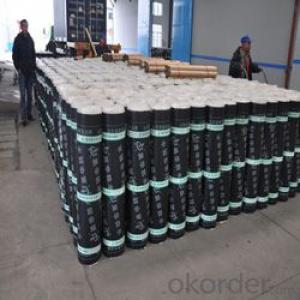EPDM Waterproofing Membrane with 1.5m Width
- Loading Port:
- Shanghai
- Payment Terms:
- TT OR LC
- Min Order Qty:
- 50000 m²
- Supply Capability:
- 5000000 m²/month
OKorder Service Pledge
OKorder Financial Service
You Might Also Like
EPDM Waterproofing Membrane with 1.5m Width
Description Of EPDM Waterproofing Membrane with 1.5m Width:
·Filament polyester filler base sheet material:
·The combination of filament polyester filler base and SBS modified bitumen forms an excellent comprehensive performance and high quality waterproof sheet material;
·High strength waterproof layer and strong water pressure resistance;
·Good performance of breaking resistance, tearing resistance, fatigue resistance, corrosion resistance, mould resistance and weather resistance;
·High tensile strength, high elongation, high adaptive capacity to base shrinkage deformation and fracture;
·Good resistance performance of low and high temperature: It could still work under -20℃ , be applicable to cold and hot regions, especially in chilly region;
·Good workability: It can be constructed by heat fusion method in the four seasons of the whole year and hot-joint is reliable and durable.
·Alkali-free glass fiber filler base sheet material:
·Combination of economical filler base and high performance SBS modified bitumen.
·Higher tensile strength, excellent resistance to high and low temperature.
·Good performance of corrosion resistance, mould resistance, weather resistance and good workability.
·Glass fiber reinforced polyester filler base sheet material:
·It is safe and eco-friendly by using mechanical mounting of construction.
·The product has better dimensional stabiliy.
Main Features of EPDM Waterproofing Membrane with 1.5m Width:
EPDM rubber waterproof membrane can operate in single layer, and is characterized by light weight, ageing resistance, with long service life, great tensile strength and high extension coefficient, which has strong adaptability to shrinkage, cracking and deformation in basic level. It can work well within -40°C to 100 °C and can be constructed with a single layer in ambient temperature. The service life of EPDM rubber waterproof membrane is up to 50 years, which is known as "King of Waterproof".
Specifications of EPDM Waterproofing Membrane with 1.5m Width:
Type | EPDM Rubber Waterproof Membrane | ||
Type | Vulcanized and Weldable | ||
Thickness | 1.2mm | 1.5mm | 2.0mm |
Weight(kg/m2) | 1.54-1.58 | 1.79-1.83 | 2.25-2.29 |
Size | 1.2m (width) * 20m (length)/roll. Weldable type could be 4m wide. | ||
Packing | 24㎡/roll, with plastic bag. (Weldable: 80㎡/roll) | ||
Usage | Roof, basement, pond, Lake, steel structure roofing, underground, tunnel, etc | ||
NO. | Item | Unit | Technical requirement | |
1 | Tolerance on size | Thickness | % | ±10 |
Width | % | ±1 | ||
length | % | Does not allow negative | ||
2 | Fracture tensile strength (normal temperature ) | Mpa | ≥7.5 | |
Fracture tensile strength(60 ℃) | Mpa | ≥2.3 | ||
3 | Breaking elongation,(normal temperature ) | % | ≥450 | |
Breaking elongation,(-20 ℃) | % | ≥200 | ||
4 | Tearing resistance | KN/m | ≥25 | |
5 | Impermeability | * | 0.3Mpa impermeable | |
6 | Bending at low temperature | °C | ≤-40 | |
7 | Elongation and contraction volume at heating | Elongation | mm | ≤2 |
contraction | mm | ≤4 | ||
8 | Hot air aging 80°CX168h | Fracture strength retention | % | ≥80 |
Rate of elongation at break | % | ≥70 | ||
9 | Alkaline (saturated Ca(OH)2 solution normal Temperature x2 168h ) | Fracture strength retention | % | ≥80 |
Rate of elongation at break | % | ≥80 | ||
10 | Ozone aging (40 degree by 168 hours ) | Elongation 40% , 500x10-2 | * | No Crack |
11 | Phytotron aging | Fracture strength retention | % | ≥80 |
Rate of elongation at break | % | ≥70 | ||
Applications of EPDM Waterproofing Membrane with 1.5m Width:
Widely used in roofs, basement, toilet ,swimming pool, and all kinds of industry and civil building waterproofing, reservoir, vivicism, bridge, underground, tunnel and dam waterproofing ,especially to the keystone waterproofing projects which is durability, high corrosion resistance and easy deformation.
Construction Site of EPDM Waterproofing Membrane with 1.5m Width:
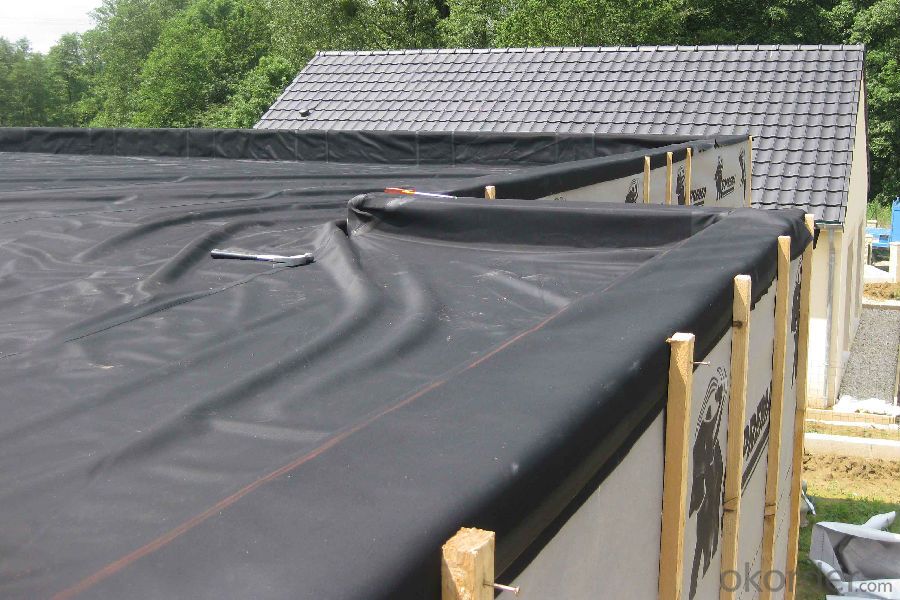
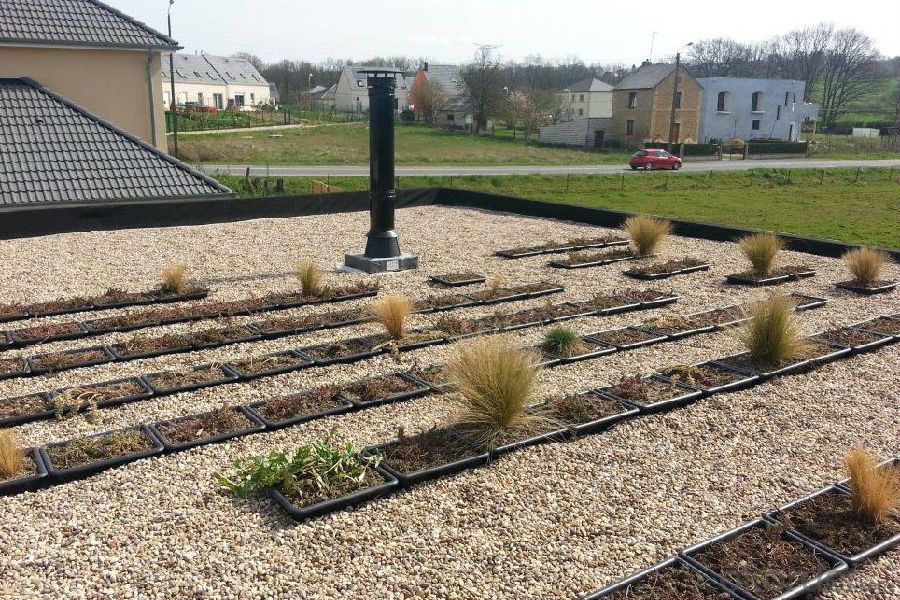
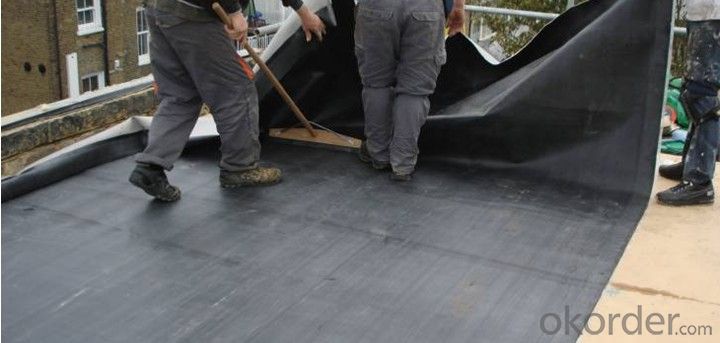
IMages of EPDM Waterproofing Membrane with 1.5m Width:

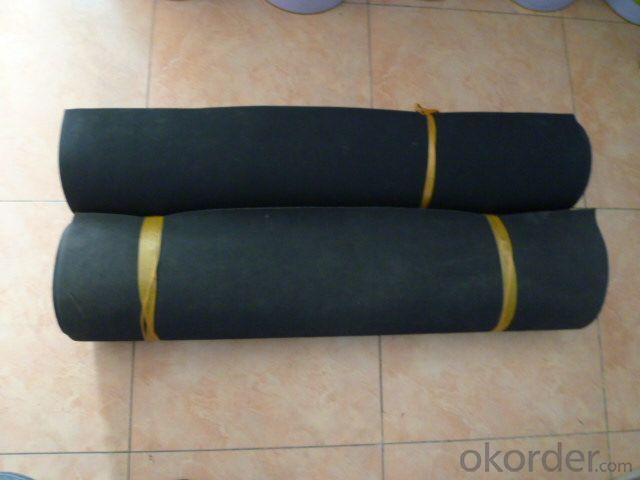
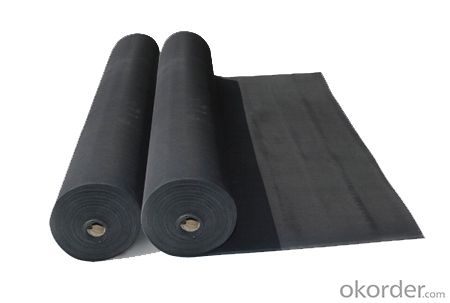
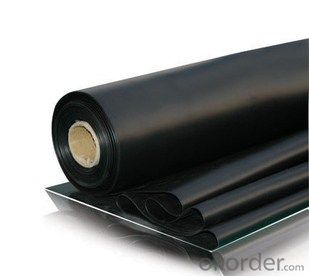
FAQ of EPDM Waterproofing Membrane with 1.5m Width:
1. What are we supplying?
We are specialized in producing Colorful Asphalt Roof Shingle, SBS/APP modified bitumen waterproof membrane, Self adhesive bitumen waterproof membrane, PVC waterproofing membrane, EPDM rubber roofing membrane, Single Component Polyurethane Waterproof Coating, and Spray Polyurea Waterproof Coating
.
2. How Many years experience do we have?
We have been exported to more than 20 countries in the past 15 years.
3. How long do we usually reply your request?
We always reply our customer within 24 hours.
- Q: Does a waterproofing membrane have any impact on the appearance of a surface?
- The appearance of a surface can be affected by a waterproofing membrane. When it is applied to a wall or floor, the membrane acts as a barrier to prevent water or moisture from entering. This process typically involves adding a coating or layer that can change the texture or shine of the surface. Occasionally, the membrane might result in a slight color variation or darken the surface. Nevertheless, there are transparent or colorless waterproofing membranes accessible that have minimal impact on the appearance of the surface. Ultimately, the extent to which the appearance is influenced depends on the specific type of waterproofing membrane utilized and the desired aesthetic result.
- Q: What is the difference between SBS and APP rolls?
- Compared to the use of SBS waterproofing membrane to use a larger range. But each has its own advantages and disadvantages, according to the local environment and the actual situation of the building in combination with the characteristics of two kinds of coil to choose materials. You have to compare the next, I can only tell you SBS waterproofing membrane prices than APP waterproofing membrane high.
- Q: Does a waterproofing membrane require any special precautions during storage?
- Special precautions are necessary when storing a waterproofing membrane. To maintain its integrity and effectiveness, the membrane should be kept in a dry and cool area, shielded from direct sunlight and extreme temperatures. Moisture must be avoided, as exposure to water or high humidity levels can compromise its performance. Furthermore, the membrane should be stored upright, rather than stacked or folded, to prevent damage or deformation. It is also advisable to keep it away from sharp objects or any materials that may puncture or tear it. Adhering to these precautions will ensure the preservation of the waterproofing membrane during storage.
- Q: Can a waterproofing membrane be used on asphalt surfaces?
- Indeed, asphalt surfaces can benefit from the application of a waterproofing membrane. These membranes, widely employed in construction, are specifically engineered to safeguard against water infiltration. Their versatility allows for application on diverse surfaces, asphalt included. By applying a waterproofing membrane on an asphalt surface, one can effectively thwart water damage, prolong the surface's lifespan, and safeguard the underlying structures. It is crucial to guarantee the compatibility of the chosen waterproofing membrane with asphalt and to adhere to proper installation techniques in order to achieve the best possible outcome.
- Q: Can waterproofing membranes be used on concrete block walls?
- Yes, waterproofing membranes can be used on concrete block walls. In fact, it is often recommended to use waterproofing membranes on concrete block walls to prevent water infiltration and moisture damage. Waterproofing membranes are designed to create a barrier against water and can be applied to the exterior or interior surface of the concrete block walls. These membranes provide an additional layer of protection, preventing moisture from seeping into the walls and causing issues such as mold growth, efflorescence, and deterioration of the concrete blocks. By using waterproofing membranes, you can ensure the longevity and durability of your concrete block walls.
- Q: Can a waterproofing membrane be used on both residential and commercial buildings?
- Certainly, both residential and commercial buildings can benefit from the application of a waterproofing membrane. These membranes are specially crafted to create a shield against water infiltration, making them indispensable for any structure, whether it be a home or a business establishment. Be it a dwelling, a multi-unit complex, a corporate office, or a retail store, the versatile waterproofing membrane can be effortlessly applied to a variety of surfaces, including roofs, walls, foundations, and basements, effectively safeguarding the building from the perils of water damage and seepage. Furthermore, these membranes come in a wide array of types and materials, ensuring that they can be tailored to meet the specific needs and demands of any building, regardless of its residential or commercial nature.
- Q: Can a waterproofing membrane be used for art installations or sculptures?
- Yes, a waterproofing membrane can be used for art installations or sculptures. Waterproofing membranes are commonly used in construction projects to prevent water infiltration and protect surfaces from moisture damage. In the context of art installations or sculptures, a waterproofing membrane can provide added durability and protection against environmental elements such as rain, snow, or humidity. This can be especially important for outdoor installations or sculptures that are exposed to the elements. Additionally, a waterproofing membrane can help preserve the integrity and longevity of the artwork, ensuring that it remains visually appealing and structurally sound over time. However, it is important to consult with professionals or experts in waterproofing to ensure the proper selection and application of the membrane, as different types may be more suitable for specific artistic materials or techniques.
- Q: What is the PEDM waterproofing membrane material?
- EPDM waterproofing membrane (EPDM) is the main material with ethylene propylene rubber, adding anti-aging agent, accelerator, and adding nano-materials, so that the waterproof membrane weather resistance, heat resistance, low temperature resistance has greatly improved
- Q: How does a waterproofing membrane perform in areas with heavy foot traffic?
- A waterproofing membrane is designed to provide a protective barrier against moisture and water penetration in various applications. When it comes to areas with heavy foot traffic, the performance of a waterproofing membrane is crucial. In such areas, the durability and strength of the membrane become essential factors. A high-quality waterproofing membrane that is specifically engineered for heavy foot traffic is capable of withstanding the constant stress and pressure exerted by people walking, running, or even using heavy equipment. One way a waterproofing membrane performs well in areas with heavy foot traffic is by maintaining its integrity and preventing any water or moisture from seeping through. It acts as a reliable shield, ensuring that the underlying structure remains dry and protected. This is particularly important in areas such as balconies, terraces, or concrete walkways, where water infiltration can lead to structural damage, corrosion, or mold growth. Additionally, a good waterproofing membrane for heavy foot traffic areas should possess excellent abrasion resistance. This means it can withstand the friction and wear caused by frequent foot traffic without deteriorating or losing its waterproofing properties. The membrane should be able to resist damage from shoes, heels, or other objects that may come into contact with its surface. Furthermore, a waterproofing membrane suitable for heavy foot traffic areas should be slip-resistant to ensure the safety of individuals walking on it. It should provide sufficient traction and grip, even when wet, to prevent accidents or injuries. This is especially crucial in spaces like swimming pool decks or commercial buildings where the risk of slipping is higher. In conclusion, a waterproofing membrane designed for heavy foot traffic areas performs by effectively sealing the surface, preventing water infiltration, and protecting the underlying structure. It should possess durability, strength, abrasion resistance, and slip resistance to ensure optimal performance and safety in areas subjected to heavy foot traffic.
- Q: Can a waterproofing membrane be used in hospitals or healthcare facilities?
- Waterproofing membranes have the ability to be utilized in hospitals and healthcare facilities. In reality, it is highly advisable to employ waterproofing membranes in these settings as it is crucial to maintain a clean and hygienic environment. Typically, waterproofing membranes are applied on floors, walls, and ceilings to prohibit the infiltration of water or moisture. This infiltration can result in the growth of mold, the deterioration of building materials, and the compromise of the facility's structural integrity. By utilizing waterproofing membranes, healthcare facilities can effectively shield against water damage, facilitate easier cleaning and maintenance, and prevent the growth of harmful microorganisms and bacteria. Furthermore, waterproofing membranes can also assist in managing moisture levels, thereby reducing the risk of slips and falls. This reduction in risk is particularly vital in areas frequently visited by patients, staff, and visitors. Overall, waterproofing membranes are an invaluable asset in ensuring the safety, durability, and cleanliness of hospitals and healthcare facilities.
Send your message to us
EPDM Waterproofing Membrane with 1.5m Width
- Loading Port:
- Shanghai
- Payment Terms:
- TT OR LC
- Min Order Qty:
- 50000 m²
- Supply Capability:
- 5000000 m²/month
OKorder Service Pledge
OKorder Financial Service
Similar products
Hot products
Hot Searches
Related keywords
